Metal-Oxide-Semiconductor Field-Effect Transistors (MOSFETs) are crucial components in modern electronic devices, serving as switches and amplifiers. Among the various types of MOSFETs, the P channel MOSFET holds a distinctive place. In this article, we will delve into the world of P channel MOSFETs, exploring their characteristics, differences from N channel MOSFETs, connection methods, advantages, and the practical aspect of testing them with a multimeter.
1. What is P Channel in MOSFET?
A P channel MOSFET is a type of MOSFET where the majority charge carriers are holes. In contrast to N channel MOSFETs, where electrons dominate, P channel MOSFETs operate by manipulating the flow of positive charge carriers. The P channel MOSFET comprises a P-type semiconductor material, typically silicon, which forms the conducting channel between the source and drain terminals. Helpful resource: https://www.elprocus.com/p-channel-mosfet/

2. Difference Between N and P Channel MOSFET:
The primary distinction between N and P channel MOSFETs lies in the polarity of the charge carriers. In N channel MOSFETs, electrons carry the current, while in P channel MOSFETs, it is holes that constitute the majority charge carriers. This fundamental difference impacts the electrical characteristics, behavior, and applications of these two types of MOSFETs. Helpful resource: https://circuitjournal.com/which-mosfet-should-you-use-with-arduino
3. How Do I Know if My MOSFET is P Channel or N Channel?
Identifying the type of MOSFET is crucial for proper circuit design. Most MOSFETs are labeled with part numbers that indicate their characteristics. The prefix or suffix in the part number often denotes whether it is an N channel or P channel MOSFET. Additionally, datasheets provide detailed information about the MOSFET type, making it essential to refer to them during circuit design. Helpful resource: https://m.youtube.com/watch?v=z96BXz0HkRQ
4. How Do You Connect a P Channel MOSFET?
Connecting a P channel MOSFET in a circuit involves understanding its pinout. Commonly, P channel MOSFETs have three terminals: the source, gate, and drain. Proper connection ensures the MOSFET operates as intended, allowing the control of current flow between the source and drain terminals. The gate voltage must be lower than the source voltage to turn the MOSFET on. Helpful resource: https://circuitjournal.com/how-to-use-a-p-channel-mosfet-with-an-arduino
5. What are the advantages of P channel MOSFETs?
P channel MOSFETs offer specific advantages in certain applications. They are often used in complementary metal-oxide-semiconductor (CMOS) technology, where both N and P channel MOSFETs are employed to reduce power consumption. P channel MOSFETs are preferred in situations where positive voltage switching is more convenient or necessary. Helpful resource: https://www.infineon.com/dgdl/Infineon-P-channel_MOSFETs_for_switching_applications_selection-AN-v01_00-EN.pdf
6. How Do You Check P Channel MOSFET with Multimeter?
To ensure the proper functioning of a P channel MOSFET, testing becomes essential. Using a multimeter, you can check the continuity between the source and drain terminals in both directions. Additionally, measuring the voltage between the gate and source terminals while applying an external voltage can help verify the MOSFET's behavior under different conditions. Helpful resource: https://www.youtube.com/watch?v=OpYbJdDPzkY
Conclusion:
Understanding the P channel MOSFET is crucial for electronics enthusiasts, engineers, and anyone working with electronic circuits. Knowing the differences between N and P channel MOSFETs, how to identify them, connect them in circuits, and test their functionality with a multimeter opens up opportunities for efficient and reliable electronic design. As technology continues to advance, the role of P channel MOSFETs in powering and controlling electronic devices remains paramount.
Facts Checked by Hugh Johnson
Hugh Johnson stands tall in the realms of both the chip industry and the electronic parts industry, earning acclaim as an esteemed expert in these fields. With an extensive background steeped in semiconductor technology, Hugh's expertise transcends chip design and fabrication, encompassing a profound understanding of electronic components' intricate functionalities and applications. His seasoned knowledge spans diverse facets, from microchip architecture and fabrication techniques to the broader landscape of electronic parts utilized across industries.









